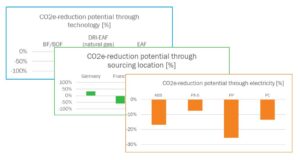Insights on Optimizing ESG Performance
Organizations across the globe are announcing net zero and decarbonization targets in light of the Paris Agreement, the EU Green Deal, and other governmental carbon and climate neutrality regulations. High pressure from investors has a significant role to play as well. However, company declarations vary widely in terms of scope and definitions of their net-zero targets. A new standard for corporate net-zero target announcements is currently under development. It will help set boundaries, streamline the process, define mitigation pathways (such as neutralization vs. removals) to make these announcements more comparable globally.
However, one important discussion is missing here. Along with direct emissions reduction and sourcing of renewable energy, indirect emissions reduction, both upstream and downstream, are the keys to decarbonization. The question then arises – how should Scope 3 emissions be calculated, and with which data, for both quantification and reduction strategy?
Supply chain decarbonization plays a critical role in achieving net-zero. This is reflected in the GHG Protocols Scope 3 Category 1 Purchased Goods and Services. But the challenge that companies face is understanding how complex purchasing lists, with x-thousand-line items, can be calculated and with which data foundations?
How Should Companies Calculate Their Scope 3 Emissions?
Surprisingly, many companies calculate these emissions at a very high level with spend-based input-output databases. As these are top-down macroeconomic assessments, they do not accurately represent the carbon emissions of the supplied products of a specific organization.
Calculating Scope 3 emissions requires using purchasing volumes, not based on financial data, but physical attributes such as weight, size, number of pieces, etc. These data points then have to be connected with high-quality emission factors on the material level, such as LCIA databases with annually updated real-industry data selected by sector and material-specific sustainability experts.
Gaining these physical quantities of purchasing lists can be challenging. Internal procurement system landscapes often capture purchase volumes at the spend level without physical attributes. The benefits of having this level of detail is worth the investment if getting meaningful and actionable data is the objective. The secret to success lies in the clear quantification of the reduction potential on a detailed, physical and scientific basis. This will help steer the organization along its strategic decarbonization pathway.

Developing the Calculation Into an Emissions Reduction Strategy
Once these emissions are assessed based on LCIA data for each material or component, they can be scaled to commodities and overall purchasing volumes. Based on a material quantification of CO2 emissions, reduction levels can be analyzed further. This could be a transparent technological comparison such as Blast Furnace (BF) vs. Electric-Arc Furnace routes for steel, primary and secondary aluminum, or the use of different propylene compositions to reduce the carbon emission for each material.
Sphera’s sustainability consulting team has deep, multi-sector expertise to support your organization. Our sector experts analyze your carbon hotspots and identify alternative emission reduction pathways. Examples may include different technology routes for manufacturing or activity improvements. 30 years of experience in performing Life Cycle Assessments makes Sphera ideally placed to assess and quantify reduction potential, compare those with your current technology and provide insights on the feasibility and timeline for implementing those carbon reduction measures.
Once reduction levers on specific material basis are identified, these can be scaled up to the overall supply chain carbon footprint based on physical volumes.

A focused strategy will enable organizations to understand, manage and reduce their upstream carbon emissions on it’s pathway towards net zero. Management will gain a clear insight into the current carbon footprint and reduction potential over time, based on the projections and the use of new technological alternatives in the future.
Sphera’s sustainability experts can conduct the initial Scope 3 assessment to help you understand the relevance of the different Scope 3 categories for your specific organization. A detailed Scope 3 study for your purchased goods and services provides you with data-driven insights into your supply chain. Sphera develops specific methods to analyze your purchasing volumes and quantify your emissions on a material basis. Automated mapping of emission factors to purchasing volumes increases efficiency and accelerates decarbonization efforts. To achieve actual reductions, Sphera’s sustainability consultants support your company in collecting primary supply chain data from hotspot suppliers, comparing their emissions to industry averages, and setting supplier-specific reduction targets.

Quantifying Scope 3 emissions on a physical and scientific basis helps your organization get a clear view of its actual emissions and provides a fact-based and science-backed approach to setting and announcing climate neutrality and net-zero targets.






